


Mercury is a barren world, which resembles Earth's Moon in many ways. (1.6.x) (1.4.1)
Mercury's spin (rotation) and orbit are "in synch"! So part of the planet experiences double sunrises! (1.6.x) (1.4.1)
Mercury is the closest planet to the Sun, so it moves in its orbit faster than any other major planet! (1.6.x) (1.4.1)

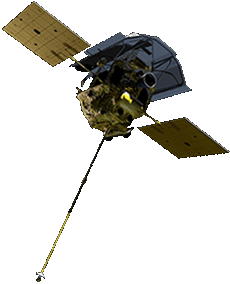
SURFACE VIEWS
Although no spacecraft has yet visited the surface of the innermost planet, much has been learned about it. Here are links to science-based representations of Mercury's Sun-baked surface, which has often been likened to the surface of the Moon.
MESSENGER Mission Site
NASA Solar System Sim
MERCURY ACTIVITIES
MAKE PAPER MODEL OF MERCURY MESSENGER SPACECRAFT
COMPARE MAPS OF MERCURY AND THE MOON
Though Mercury resembles the Moon at first glance, each world has its own character. Use the QuickMaps below to gain a better understading of how Mercury and the Moon are alike and different:
Does Mercury have any large maria on it? On closer exam- ination these 2 worlds, which at first glance appear so sim- lar, are really quite different!
MERCURY'S
CURIOUS ORBIT
Among the orbits of the eight major planets, Mercury's can be said to be the "orbit of superlatives". It is inclined to the Ecliptic more than any other orbit of a major planet, and it also has the highest eccentricity! Moreover, as we have already seen, the fleet planet's orbit and spin are synchronized more than those of any other major planet!
Mercury's orbit may be the most intriguing in the Solar System for another reason! As seen a bit below in the center column, the orbit of Mercury "rotates" around the Sun! This phenomenon is called the "Precession of Perihelion", and the orbits of all celestial bodies exhibit a similar motion, though to a significantly lesser degree. Even in Mercury's case, its rate is extremely slow—only about 1/6 of a degree each century. This means that it takes over 200,000 years for Mercury's "orbit" to rotate once around the Sun! Even so, that is still faster than could be accounted for by Newton's Law of Gravitation.
It was not until Einstein's
General Theory of Relativity that the rate of Mercury's Precession of Perihelion could be explained.
![]()
CELES-TIPS
The following will help you enjoy this page's 1.6.x and 1.4.1 links that run events directly in CELESTIA. If you're new to the program, these tips will also help you learn to use it.
Are you unfamiliar with our 1.6.x and 1.4.1 links? For an explanation click here.
You'll find more information about many of CELESTIA's controls on our Learning Center page.
MERCURY
View Mercury in 3-D Another Another
![]() 3-D in Orbit
3-D in Orbit
QuickMap 3-D Globe w/Labels Mercury Trek
Current Views and Conditions from Earth
Current Location in the Constel. Skypath 2025
Current Location in Orbit
Current Year's Greatest Elongations List
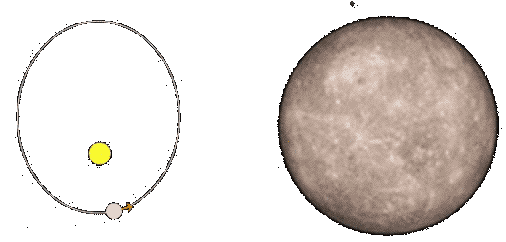
Viewed from the Sun, Mercury exhibits a peculiar motion. Its spin & elliptical orbit are synchronized,
so it appears to stop rotating every time it reaches perihelion!
Next Transit: 2032 Nov 13
![]()
Physical Properties:
Equatorial Size: Compare in 3-D
Radius: 2,440 km
Diameter: 4,880 km

Diameter (Earth = 1): 0.383
Rotational Flattening: 0
Mass (Earth = 1): 0.055
Volume (Earth = 1): 0.056
Mean Density (Water = 1): 5.43
Mean Density (Earth = 1): 0.984
Surface Gravity (Earth = 1): 0.378
Surface Temperatures: average 167°C (332°F) ![]()
Axial Tilt: 0.0° ![]()
Where Poles Point ![]()
Rotation Period:
Synodic ("Day" in Earth solar* days): 175.942
Sidereal (Earth solar* days): 58.65
Note: Earth Day Lengths
Mean Solar: 24.0000 hours (24h00m00s)
Sidereal: 23.9345 hr (23h56m4.1s)
Albedo (geometric): 0.14
Magnetic Field (Earth = 1): 0.017
NASA Messenger Site Graphic
NASA/JPL PhotoJournal Site Graphic
![]()
NASA's Overview of Mercury
NASA Mercury In Depth page
MESSENGER Mission Site
NASA Space Place: All About Mercury
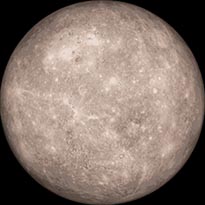

COMPARE MERCURY TO EARTH'S CONTINENTS
Mercury Surface:
Global Views (greyscale):
North Pole South Pole
0° North, 0° East 0° North, 90° East
0° North, 180° East 0° North, 270° East
Images from Messenger:
Highlights Collections
Global Mosaics
Featured Image Database
Study Mercury's Surface with QuickMap
Map of Mercury's Surface ("enhanced color"):
Global Mosaic Map (3.74 km per pixel)
NASA explanation of "enhanced color" map
NASA / JPL's Photojournal pages for Mercury
Rachmaninoff Crater 3-D Rotation ![]()
NASA Mercury Enhanced-Color Rotation Vid
Mercury Atmosphere: tenuous
Surface Pressure (Earth = 1): 10‒14
Origin: Solar Wind, Planet's Crust, Meteoroids
Wikipedia page
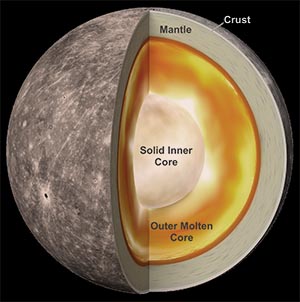
Mercury Structure:
Compared to Other Inner Planets
![]()
A Mystery Solved
Spacecraft:
BepiColombo in 3-D (Attitude Viewer) rotate & zoom
ESA Mission Sites: #1 #2
Wikipedia page
3-D Interactive Trajectory scroll, zoom, drag, play
Mercury Messenger:
Mission Sites: JHUAPL NASA
Wikipedia page
3-D Models (shapes only): #1 #2
Number of Moons: 0
Ring System: No
Planet Classifications:
Inner Planet (along with Venus, Earth & Mars)
Terrestrial Planet (primarily Earth-like structure)
Inferior Planet (has smaller orbit than Earth and
exhibits a full range of phases)
Current Phase of Mercury
Phases of the Inner Planets Video
Phases of Mercury Sim (in Orbit Sizes box
select Mercury as target)
Configurations Sim (in Orbit Sizes box
select Earth and Mercury)
No. of Greatest Elongations per Yr: 6 or 7 ![]()
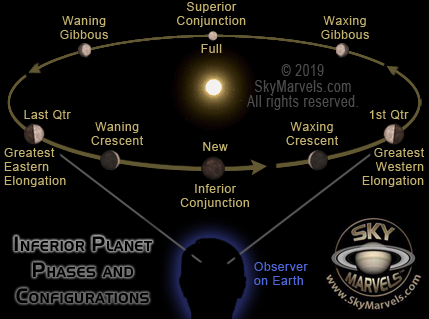
Mercury Orbit:
(1.6.x)
(1.4.1)
Period: 87.969 Earth solar days
Distance from Sun:
Mean (Earth = 1 AU): 0.387 AU
Mean: 57,910,000 km
Perihelion: 46,000,000 km (0.307 AU)
Aphelion: 69,820,000 km (0.467 AU)
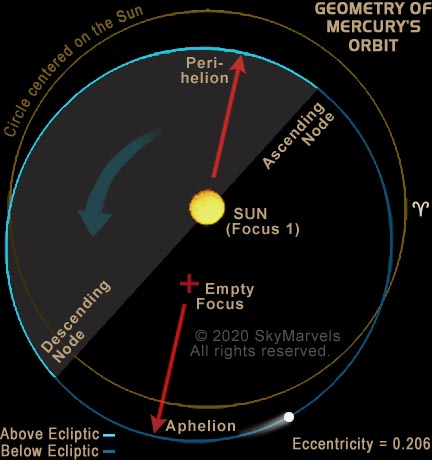 Velocity:
Velocity:
Mean: 172,332 km/hr
Min: 139,896 km/hr
Max: 212,328 km/hr
Eccentricity: 0.206
Inclination to Ecliptic: 7.00°
Spin-Orbit Resonance: Yes, 3 to 2
(verify Mercury's 3 rotations in each 2 orbits)
this produces Mecury's "double sunrises"
![]()
Precession of Perihelion: 574 arc-sec / century
![]()
APPARENT SIZE OF THE SUN FROM MERCURY
AND THE OTHER MAJOR PLANETS
View with "Scale of the Cosmos" tool.
MERCURY'S SPIN-ORBIT RESONANCE
AND PRECESSION OF PERIHELION
Mercury's elliptical orbit itself actually rotates very
slowly around the Sun! Its perihelion "precesses"
a full 360° once roughly every 225,000 years!
(Note: Eccentricity and speed of Precession
are greatly exaggerated for emphasis.)
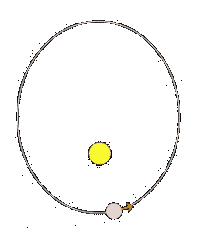
The precession of Mercury's perihelion stands as
one of the enduring proofs of General Relativity.
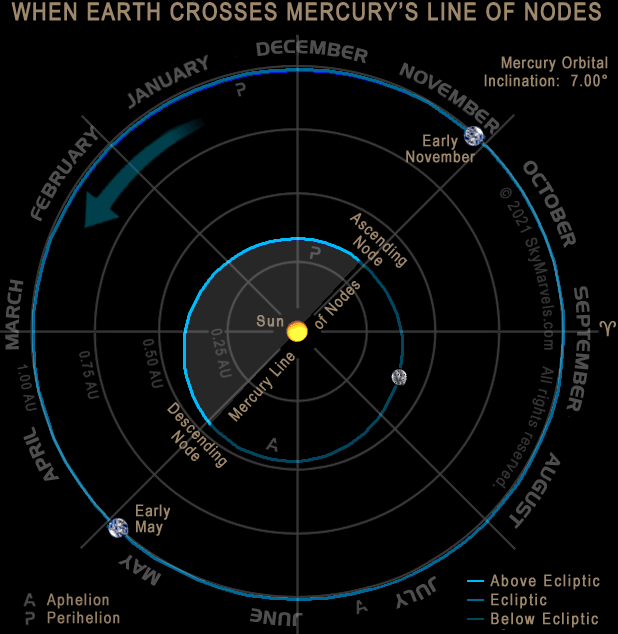
When Mercury's Orbit Appears "Edge-On" from Earth
Transits (in front of the Sun):
Frequency: approx 13 per century
7-Century Catalog
Why All Currently Occur in May or November
Last 2 Transits:
2016 May 9 SDO Video
![]() 2019 Nov 11
2019 Nov 11
![]() SDO Video
SDO Video
![]()
Next 2 Transits: 2032 Nov 13
![]() ; 2039 Nov 7
; 2039 Nov 7
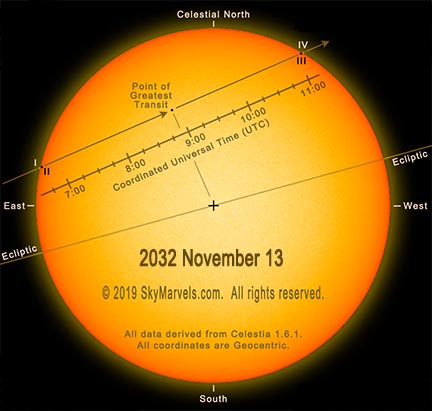
Wikipedia's Transit of Mercury page
Properties of Mercury's Transits:
May Transits:
• occur near Mercury's Descending Node
• progress to the southwest
• are less numerous than Nov transits
• occur when Mercury looks larger
November Transits:
• occur near Mercury's Ascending Node
• progress to the northwest
• are more numerous than May transits
• occur when Mercury looks smaller
NASA Video of the 2016 May 9 Transit
![]()
NASA Graphic of the 2006 Nov 8 Transit
Best Times to View Mercury: when Greatest . . .
Eastern Elongations occur betw. March & July
Western Elongations occur betw. Sept. & Dec.
Partial Information Source: NASA Fact Sheets
ADJECTIVES MEANING
"pertaining to Mercury"
Mercurian
Hermian (from Greek god, Hermes)
MERCURY: Its Phases as an Inferior Planet
MERCURY'S & VENUS'S SKY PATHS 2013–2014
MERCURY
video credit: Science@NASA
MERCURY: Its Weird Solar Day over its South Pole
video credit: NASA/Johns Hopkins University Applied Physics Laboratory/Carnegie Institution of Washington
MESSENGER: Mercury Orbit Insertion
video credit: NASA/Johns Hopkins University Applied Physics Laboratory/Carnegie Institution of Washington
DIRECT LINKS TO MORE VIDEOS
From NASA's Photojournal pages, here's A Tribute to MESSENGER ![]()
From NASA's Photojournal pages, here's Mercury: Getting the Spins ![]()
From NASA's Photojournal pages, here's A Bit of an Exaggeration ![]()
Home Intro News Gallery Sky-Gifts Bonuses Tips
Learning Ctr Help Links Credits Legal Contact Us
© 2007-
by Gary M. Winter. All rights reserved.
Interested in political cartoons and humor?
Check out The HIPPLOMATS™.
SkyMarvels, Sky Marvels, SkyMarvels.com, MERCURY Info. MERCURY. All about the planet MERCURY. MERCURY'S Structure. MERCURY'S 3/2 Spin-Orbit Resonance, MERCURY'S Spin-Orbit Resonance. MERCURY'S weird double sunrises, celestia4all, celestiaforall, CELESTIA, astronomy, space, simulations, animations, downloadable astronomy posters, stars, planets, Inner Planets, Outer Planets, Inferior Planets, Superior Planets, moons, asteroids, comets, Oort Cloud, galaxy, galaxies, Milky Way, Andromeda, globular clusters, binaries, quasars, black holes, supermassive black holes, telescope, telescopes, planetarium, software, freestuff, satellites, add-ons, addons, scripts, eclipses, Solar Eclipses, Lunar Eclipses, Solar Eclipse Finder, Lunar Eclipse Finder, mutual eclipses, transits, occultations, Solar System, CELES-TOOLS, celeSTARrium, CELX, CELX programming, Freebies, Bonuses, multiple views, atronomical unit, light year, parsec, meteors, meteor showers, Perseids, Geminids, Leonids, barycenter, time, Time Zones, tides, alignments, conjunctions, oppositions, seasons, apogees, perigees, aphelion, perihelion, Earth, Luna, Mercury, Venus, Mars, Jupiter, Galilean Moons, Io, Europa, Ganymede, Callisto, Saturn, Titan, rings, Uranus, Neptune, Triton, E-MSpectrum, electromagnetic spectrum, astronaut, equinoxes, solstices, precession, rotation, spin, inclination, tilt, Ecliptic, orbits, ellipse, parabola, hyperbola
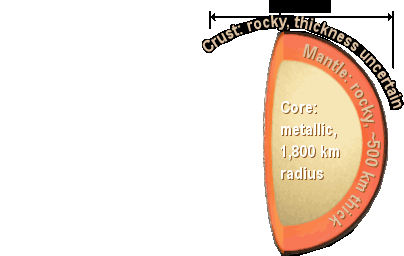
Donate safely with: PayPal
and receive one or more
Sky-Gifts. Your support is greatly appreciated!
NOTE: you do not need a PayPal account to donate.
SKY VIEWING
SOLAR SYSTEM
THE SUN
MERCURY
VENUS
EARTH
THE MOON
MARS
JUPITER
SATURN
URANUS
NEPTUNE
SMALLER WORLDS
STELLAR OBJECTS
EXOPLANETS
DEEP-SKY OBJECTS
SCALE OF THE COSMOS
———————
SKY-FUN / SKY-GAMES
NASA's LATEST
MERCURY MESSENGER status (completed mission with impact on Mercury as planned on 2015 Apr 30)
ESA's LATEST
Where is BepiColombo? cool interactive from ESA.
BepiColombo in 3-D (Attitude Viewer) rotate and zoom
MERCURY FUN FACTS
Mercury's surface area
is close to the combined
areas of Asia and Africa!
Mercury, smallest of the eight major planets, is smaller than Jupiter's moon Ganymede & Saturn's moon Titan!
The precession of Mercury's perihelion stands as one of the great enduring proofs of Einstein's General Theory of Relativity!
Relative to its size, Mercury is the most metal-rich major planet!
Of all the other planets, it is Venus which has an orbit closest in size to that of Earth. And yet, because of how the planets orbit the Sun, the major planet that spends more time closer to Earth than any other turns out to be Mercury! It's aver- age distance from Earth is quite a bit less than Venus's!
In fact, not only is Mercury the planet closest to the Sun, it is also the planet closest (on average) to each and every other major planet in our Solar System! ![]()
Mercury exhibits phases like those of the Moon! However, unlike the lunar phases, that appear to march across the Moon's surface from west to east (relative to our sky di- rections), Mercury's phases appear to us on Earth to pro- gress "backwards", that is, across its surface from east to west!
The durations of Mercury's phases are not as uniform as the Moon's phases! Because it is an Inferior Planet, for a good bit more than half of its orbit Mercury appears more than "half-illuminated" to us here on Earth!
Some locations on Mercury experience double sunrises and sunsets! Other locations experience days where the Sun stops in the sky, eases backward, then goes forward again! Mercury's spin-orbit resonance is responsible for this odd behavior.
Mercury's day is almost one half of an "Earth year" long!
Relative to its overall size, Mercury has a larger metallic core than any other planet!
Though the 8 major planets do not possess particularly elongated orbits, Mercury's orbit is the most elongated or elliptical of them.
Mercury is so near the Sun that it is difficult to observe. Most often it is hidden in the Sun's glare. So a relatively small percentage of persons has ever seen Mercury in the sky! If you've seen it, you are one of the lucky ones!
Mercury's lack of moons is partly due to its nearness to the Sun! The solar gravity makes it harder for Mercury to retain orbiting bodies.
MERCURY INTERACTIVES
QUICK ACCESS LIST
Note: some links are echoed elsewhere on this page and may include descriptive text.
View Mercury in 3-D superb!
Another Another
![]()
Study Mercury's Surface with QuickMap
Links to interactive features that show Mercury's orbit in 3-D can be found on our Solar System page
Where is BepiColombo? cool interactive from ESA.
BepiColombo in 3-D (Attitude Viewer) rotate and zoom
MESSENGER Games and Simulations You'll have to ZOOM IN your new window to enjoy these, but it's worth it. The best three are included below to make accessing them a little easier!
Day on Mercury How the Sun appears to halt in Mercury's sky! Don't forget to zoom in.
Sun's Size in Earth's and Mercury's Skies shows how Mercury's highly elliptical orbit makes the Sun appear notably larger at perihelion than at aphelion. Don't forget to zoom in.
Mercury's Orbit & Rotation shows its 3 to 2 spin-orbit resonance, also comparing Mercury's orbit and spin characteristics to Earth's. Don't forget to zoom in.
SKYMARVELS™
VIDEOS FEATURING MERCURY